the place where Paleontology and Paleoanthropology meets Philately
The Maldives
Fossils and reconstructions of dinosaurs and other prehistoric animals on stamps and postmarks of Maldives.
| << previous country | back to index | next country >> |
Contents:
- Country overview
- Philately of the Maldives
- Official stamps of the Maldives related to Paleontology
- Commemorative postmarks of the Maldives related to Paleontology
- References
- Acknowledgements
The Maldives, officially the Republic of Maldives, is a South Asian island country, located in the Indian Ocean. It lies southwest of India and Sri Lanka. The chain of twenty six atolls stretches from Ihavandhippolhu Atoll in the north to Addu City on the Addu Atoll in the south.
Comprising a territory spanning roughly 90,000 square kilometres, the Maldives is one of the world's most geographically dispersed countries, as well as the smallest Asian country by both land area and population (of approximately 400,000 people).
Malé is the capital and most populated city, traditionally called the "King's Island" for its central location.
The Maldive Islands was a British Protectorate, first as a dependency of Ceylon, then from 1948 as an independent sultanate, except for a year (1953) as a republic.
The islands became completely independent on July 26, 1965 and became a republic again on November 11, 1968. [R1]
The first stamps used in the islands were overprinted stamps of Ceylon issued on 9 September 1906. When those ran out, un-overprinted stamps of Ceylon were used. The first stamps inscribed "Maldives" were issued on 15 May 1909. [R2]
According to the Michel-online catalog, the first few years after gaining independence, the Post Authority of the Maldives issued a reasonable number of stamps per year.
By the end of the 1980s, the number of stamps issued increased significantly. Stamps became a source of income for the island country from sales to collectors.
The increase in number of stamps issued were accommodated by the release of stamps showing a wide variety of popular thematic topics – most without any link to the country’s culture or natural history.
During the first year (1972) that the Maldives issued prehistoric animal stamps, the country published 41 stamps.
In 1992, the year the second prehistoric animal set was issued, the country issued 215 stamps!
The following years, the Post of the Maldives continued to issue more than 200 stamps per year.
In 2012, the Maldives contracted Stamperija to produce stamps on the country’s behalf.
In 2018, Stamperija issued over 800 issues for the Maldives, while in 2019 almost 700 stamps were issued.
Official stamps of Maldives related to Paleontology: dinosaurs and other prehistoric animals, Charles Darwin
| 31.05.1972 "Prehistoric Animals" [1] | 15.09.1992 "International Stamps Show GENOVA'92 in Genoa - Prehistoric Animals" [2] | 20.06.1994 "The Ages of Dinosaurs" [3] |
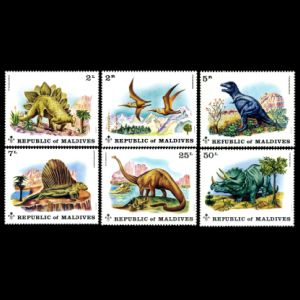 |
 |
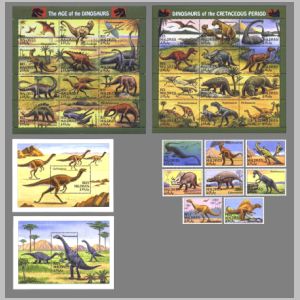 |
| 20.11.1997 "Prehistoric Animals" | 22.06.1999 "Prehistoric Animals" | 21.05.2002 "Prehistoric Animals" |
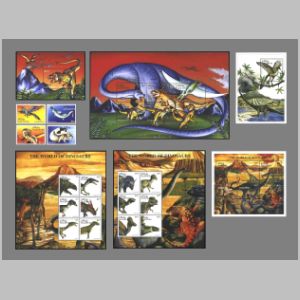 |
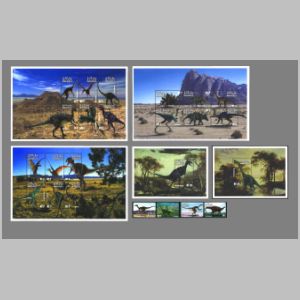 |
 |
| 26.01.2005 "Prehistoric Animals" | 14.10.2014 "Dinosaurs" | 25.05.2015 "Prehistoric Fauna: Dinosaurs" |
 |
 |
 |
 |
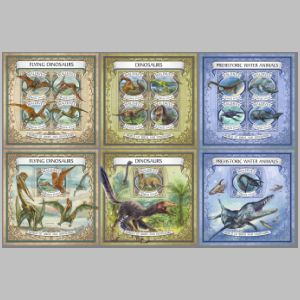 |
 |

|
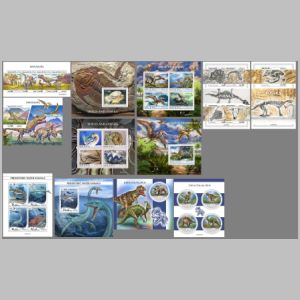
|

|
Notes:
[1] "Prehistoric animals" from 1972.
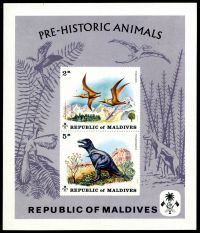
|
| Souvenir Sheet with images of two stamps from the set of "Prehisroric animals" from 1972. MiNr.: Bl.13 , Scott: N/A |
-
A souvenir sheet with images of two stamps from the set was released in a limited edition.
The souvenir sheet shows Archaeopteryx, Rhamphorhynchus and a theropod dinosaur on the margins.
Some magazines mention that 5000 pieces were issued for promotional purposes.
The sheet was made from thick paper was invalid for use as postage. It is listed in both the Michel and Scott Catalogs.
However, both catalogs doubt their origin. Michel comments that the official edition of the sheet is doubtful.
Scott states that the Souvenir sheet with 2 stamps and simulated perforation was not regularly issued. Perhaps, this is why the Scott Catalog did not give this issue a specific catalog number.
Regardless, some collectors consider it for their collections.
- These stamps also exist in an imperforate version, but their use for postage is doubtful. They are likely also promotional materials similar to the Souvenir sheet.
- FDC for this set does not exist.
[2] The only stamp set of prehistoric animals of Maldives with commemorative postmarks on the FDC. Perhaps, because this stamp set was issued for the “international Stamp Show, GENOVA “92” in Genoa, Italy.
[3] A similar design, but different size was used for the “World of Dinosaurs” sheet issued by Tanzania in 1994.

Similar stamps of dinosaurs and other prehistoric animals issued by Maldives and Tanzania in 1994.
Maldives (20.06.1994) - MiNr.: 2157-2168, 2169-2180 , Scott: 1969, 1970. Tanzania (26.12.1994) - MiNr.: 2000-2015 , Scott: 1250.
In 1994, both countries outsourced the production of their stamps to the IGPC Agency. In that year, IGPC produced 221 stamps for the Maldives and 378 stamps for Tanzania, including many dinosaur stamps for both countries.
[4] "Flying dinosaurs" is not a correct term to apply to the animals shown on these stamps. The animals pictured are pterosaurs.
Pterosaurs are a group of flying reptiles in the Archosauria. Reptiles in the archosaurs include crocodiles, dinosaurs, and pterosaurs.
Commemorative postmarks of Maldives related to Paleontology: dinosaurs
Legend is here| 15.09.1992 "International Stamps Show GENOVA'92 in Genoa - Prehistoric Animals" [FDC] [3] | ||
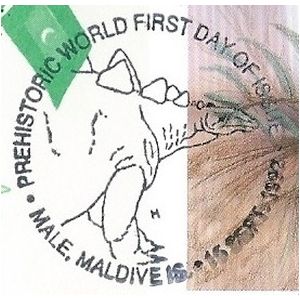 |
|
|
References:
- [R1] Maldives:
Wikipedia,
WikiTravel,
FlagCounter.
- [R2] Postal History and Philately of Maldives:
Wikipedia,
Links to official website of the Post Authority, stamp catalog and a list of new stamps of Maldives are here
Acknowledgements:
Many thanks to Dr. Peter Voice from Department of Geological and Environmental Sciences, Western Michigan University, for the draft page review and his valuable comments.
| << previous country | back to index | next country >> |